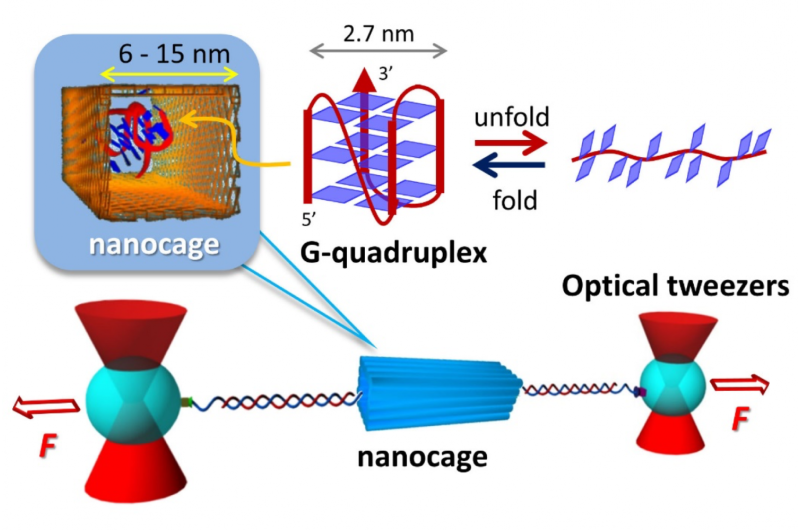Nanocages dramatically facilitate structure formation of biomolecules

Macromolecules regularly fold and unfold themselves inside cells. Their diverse three-dimensional structures help determine their functions. Understanding molecule folding can shed light on complex physical processes that may influence diseases, cancers and allergies.
G-quadruplexes are groups of guanine nucleic acids, the 'G's in the DNA sequence, that form specific shapes that look like futuristic, three-story office buildings. They were long dismissed as not having a biological function, but are now thought to help regulate gene expression, including for diseases. Understanding the physical processes that these compounds undergo when folding into extra-tight spaces may one day help develop drug treatments that target them.
Conducting experiments to learn about the folding process in confined areas is extremely challenging because it is easy to disturb not only the target molecule, which is just a few nanometers long, but also the surrounding infrastructure, which is just a fraction larger.
A team led by Hiroshi Sugiyama and Masayuki Endo of Kyoto University's Institute for Integrated Cell-Material Sciences (iCeMS) collaborating with the team from Kent State University designed structures and experimental system that successfully manipulates G-quadruplexes inside nanocages, which are also made of DNA. The team measured how different-sized spaces affect the thermodynamic stability and unfolding and folding kinetics of these molecules.
"Under the confined nano-space, the G-quadruplex structures revealed unprecedented fast folding kinetics with increased mechanical as well as thermodynamic stabilities, which directly supported theoretical predictions," the researchers conclude in their study published recently in the journal Nature Nanotechnology.
The researchers built rectangle-shaped nanocages out of DNA that they wrapped around a G-quadruplex molecule. Tethers made of yet more DNA attached the molecule to two beads. The beads, controlled by lasers known as optical tweezers, exerted force on the molecule. This prompted the molecule to unfold and then refold. There was no interference between the nanocage and the target, because they both have negative charges and repel each other like magnets.
The team built small, medium and large nanocages. The molecules unfolded and refolded 100 times faster in the small and medium nanocages compared to molecules without nanocages.
The findings support predictions made by other researchers in the field, but this is the first demonstration with no interaction between the molecule and the cage. The researchers anticipate that the method can be applied for observation of other biomolecules such as proteins using more precisely designed nanocages.
More information: Prakash Shrestha et al, Confined space facilitates G-quadruplex formation, Nature Nanotechnology (2017). DOI: 10.1038/nnano.2017.29
Journal information: Nature Nanotechnology
Provided by Kyoto University



















